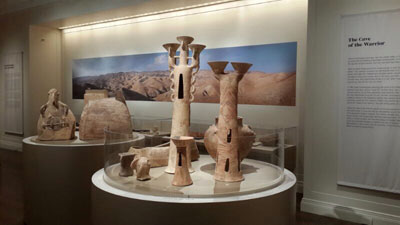The Chalcolithic culture flourished in Israel from the fifth to the second half of the fourth millennium BCE. The distribution of settlements stretches from the Negev and the Judean Desert in the south to the Golan in the north, and includes dwelling, cult and burial sites. New production technologies were introduced during this period, and regional and inter-regional trade relations were strengthened. Pottery production became more industrial in nature, with the beginning of the use of the ‘slow wheel’ and improvements in firing techniques. For the first time, too, tools and prestige and religious objects were cast from copper, some of them using the ‘lost-wax’ casting technique. Alongside the metal industry, the basalt, bone, shell and ivory industries also thrived, and were used to create prestige and cult objects such as bowls, chalices, sculptures, figurines, beads and pendants.

The Chalcolithic exhibition Masters of Fire: Copper Age Art from Israel was organized by the Israel Antiquities Authority, the Israel Museum, and New York University’s Institute for the Study of the Ancient World (ISAW).
The exhibition features a selection of 200 finds illustrating the story of this unique culture and focusing on the following topics:
Metallurgy – mace heads, maces, crowns, scepters and ceremonial staffs uncovered in the Cave of the Treasure in Nahal Mishmar.
Burial and burial rites – ossuaries, incense burners, pottery and grave goods recovered from the burial chamber at Peqi’in; textiles, woven mats and baskets, leather sandals, wooden and bone artifacts from the Cave of the Warrior in the Judean Desert.
Spiritual life and practices – anthropomorphic and zoomorphic figurines made of clay, stone, bone and ivory, recovered from the sacred compound at Gilat and sites in the Beer Sheva Valley; house-idol statues recovered from sites in the Golan.
Click to view a film of the exhibition
The exhibition is on display at:
Legion of Honor, Fine Arts Museums of San Francisco. June 28, 2014 – January 4, 2015.
The exhibition was also recently displayed at:
Institute for the Study of the Ancient World at New York University. February 13 – June 8, 2014